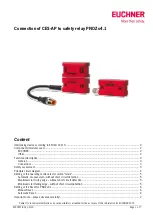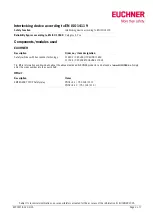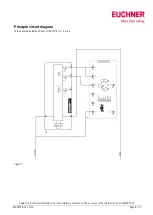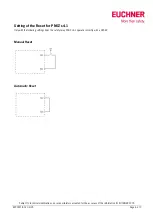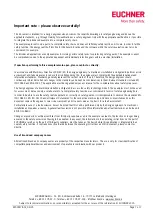
Subject to technical modifications, no responsibility is accepted for the accuracy of this information. © EUCHNER 2015
AP000178-02_03/15
Page 7 of 7
Important note – please observe carefully!
This document is intended for a design engineer who possesses the requisite knowledge in safety engineering and knows the
applicable standards, e.g. through training for qualification as a safety engineer. Only with the appropriate qualification is it possible
to integrate the introduced example into a complete safety chain.
The example represents only a part of a complete safety chain and does not fulfill any safety function on its own. In order to fulfill a
safety function, the energy switch-off function for the hazard location and the software within the safety evaluation must also be
considered, for example.
The introduced applications are only examples for solving certain safety tasks for protecting safety guards. The examples cannot
be comprehensive due to the application-dependent and individual protection goals within a machine/installation.
If questions pertaining to this example remain open, please contact us directly.
In accordance with Machinery Directive 2006/42/EC, the design engineer of a machine or installation is obligated to perform a risk
assessment and take measures to reduce the risk. When doing this, the engineer must comply with the applicable national and
international standards. Standards generally represent the current state of the art. Therefore, the design engineer should
continuously inform himself about changes in the standards and adapt his considerations to them. Relevant standards include EN
ISO 13849 and EN 62061. This application must be regarded only as assistance for the considerations about safety measures.
The design engineer of a machine/installation is obligated to assess the safety technology himself. The examples must not be used
for assessment, because only a small excerpt of a complete safety function was considered in terms of safety engineering here.
In order to be able to use the safety switch applications correctly on safety guards, it is indispensable to observe the standards EN
ISO 13849-1, EN ISO 14119 and all relevant C-standards for the respective machine type. Under no circumstances does this
document replace the engineer’s own risk assessment, and it cannot serve as the basis for a fault assessment.
Particularly in case of a fault exclusion, it must be noted that this can be performed only by the design engineer of a machine or
installation and requires a reason. A general fault exclusion is not possible. More information about fault exclusion can be found in
EN ISO 13849-2.
Changes at products or within assemblies from third-party suppliers used in this example can lead to the function no longer being
ensured or the safety assessment having to be adapted. In any event, the information in the operating instructions on the part of
EUCHNER, as well as on the part of third-party suppliers, must be taken as the basis before this application is integrated into an
overall safety function. If contradictions should arise between the operating instructions and this document, please contact us
directly.
Use of brand and company names
All mentioned brand and company names are property of the respective manufacturers. The use is only for clear identification of
compatible peripheral devices and environment of operation in combination with our products.
EUCHNER GmbH + Co. KG · Kohlhammerstraße 16 · 70771 Leinfelden-Echterdingen
Telefon: +49 711 75 97 -0 · Telefax: +49 711 75 97 -303 · info@euchner.de · www.euchner.de

